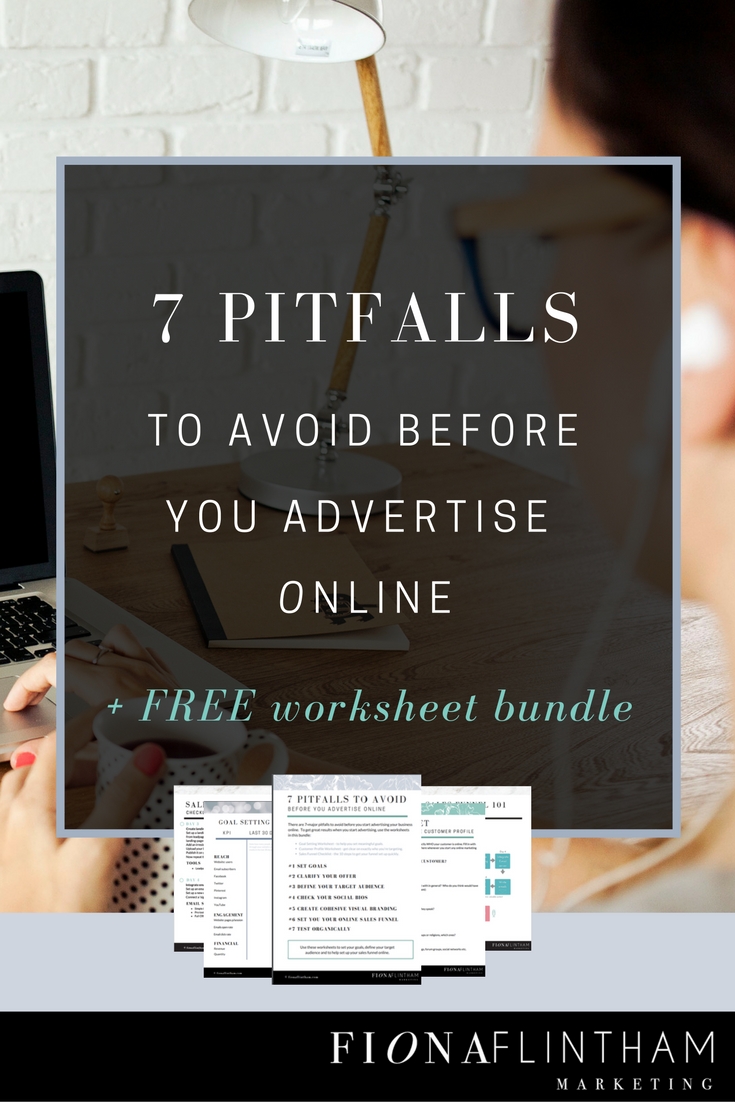7 Pitfalls To Avoid Before You Advertise Online
Ever thought about advertising your business online? You know you have a great product (or service). And your existing customers are happy.
But you could do with more. More customers, more sales.
But isn’t there a niggling feeling that it might be a whole waste of time and money? You’ve heard horror stories about how hard it is to get started with online advertising, and what a waste of effort and money it can be.
And of course, getting started is painfully overwhelming!
Most people who jump right in on their own with no experience get mediocre results. . .Then give up. Fact.
That’s not to berate you if you’re an action taker – gosh no, this is 100x better than doing nothing! You’re to be congratulated.
And if this is you, read on. I’m going to help you quash that overwhelm and avoid the mistakes that most small businesses make when they start advertising online. Plus, there’s a free worksheet bundle for you with step-by-step checklists to get you through this quickly and painlessly. Yay.
Even if you’ve only considered advertising, don’t waste any more time until you’ve ad-proofed your online business first. That’s if you want your Facebook, Google Adwords, Twitter ads or promoted pins to work.
I’ve spent many many years creating advertising campaigns for new launches and large corporations. I’ve worked with huge brands and with tiny startups. And I can tell you confidently that there are 7 pitfalls you need to know before you advertise your business online.
#1 No Goal
When you decide to go on a day trip, do you pack your bag, check the weather and head out to the car? Do you jump in, start the engine and set off driving, following any route that takes your fancy?
Of course you don’t!
You decide exactly where you want to go first. Then you check the map for the best route, and then get yourself ready right?
Advertising is just like that. You’ve got to define your destination.
So first up, get your key performance indicators (KPIs) in order by answering this:
What does success look like? For example do you want:
Another 10,000 people to know about you within the next 30 days?
To build your community with another 500 members?
To gain 1,000 new relevant leads with your $1,500 budget?
To sell 30% more products than last month?
When I was responsible for digital analytics for a large corporation, I used to spend hours setting KPIs and tracking and reporting on the performance of our digital marketing. Which got me stuck on setting goals.
These days I use my Daily Greatness Business Planner, which is truly awesome for small business owners. It helps me to track 90 days goals.
But I also track my performance with a simple set of KPIs every month. I often get asked for help on setting goals, and so I created the goal setting worksheet:

This is a system that allows you to track the most important metrics in your online business – especially if you are (or considering) advertising. Using this worksheet you can benchmark your current performance and set meaningful goals. This worksheet is part of the free bundle I put together for you – just click the link below:
The framework is one which big businesses use to monitor their performance. But I’ve adapted it for you – simplified it so you can focus on the important metrics to be tracking in your business. Download the Pre-ad bundle and complete the goal tracking worksheet first.
Once you’ve defined success, you’ll feel clearer about how to achieve it.
#2 Unclear Offer
Next decide what you’re going to offer and how you’ll present it to your audience. Maybe you have an idea based on seasonal trends or on certain things you know they’re struggling with?
To make this easier let me break it down into 3 easy steps:
1. What is the exact result you can help your prospect achieve? Can you put a time frame on it?
For example: “How to teach your kids to read by age 3 by spending 5-minutes on this ONE thing every day.”
2. Now define the specific steps they must take to get from where they are now, to the outcome you provide.
For example: “Sign up for our kids phonics programme, download our fun activities pack and print and play the recommended daily game…”
3. What’s your Unique Selling Point? This is crucial if you want to grab peoples attention. Why should they buy from YOU? What makes you different to the others in your niche?
Think about why your business is different? Is it because you’re got a decade of industry experience, or you have developed your product to overcome your own problems? What’s your unique angle? What sets you apart from the others?
For example, I’m an online marketing strategist. Pretty broad right?
But because I worked at The Walt Disney Company and helped launch a parenting website. I helped drive it from zero to 2.5m visitors every month, and it became #3 in the market in under 18 months. So I use this specific skill targeting mums online to differentiate myself. Many of my clients now fall into this market – it’s what I like to focus on, and enjoy doing.
What makes you, your offer or your product unique and different?
#Targeting Everyone
You hear it all the time don’t you?
“just as soon as you figure out who you want to target, you’ll start getting great results….
Problem is, figuring out EXACTLY who to target is so much harder than most people credit.
It’s a bit scary to narrow yourself down to just one niche isn’t it?
What if you end up putting potential customers off? Won’t you alienate paying clients by going hell bent on just one type of audience?
Trouble is, the online world is a ridiculously crowded market now. Even the biggest companies with huge budgets struggle to cut through the noise and competition.
Which is exactly why it’s vital your customers feel you understand them and their needs explicitly. In intimate detail.
Do you remember the last advert you clicked on?
Chances are that you were painstakingly targeted to see that particular ad. Chances are that the words and pictures used on that ad had been researched and tested to appeal just to you.
Might be based on previous websites you’ve viewed, purchases you’ve made, Facebook pages you’ve liked and your age, your marital status or even your household income.
Oh yes – all of that can be done and is being done by thousands of companies every day when they advertise on Facebook.
Bit scary? It’s all about data. And the great thing is, that nowadays YOU can use this laser-targeted data driven approach to promote your business too. But you need the foundations right first.
And the first step is to know exactly who you want to target in thorough detail. And I don’t just mean demographics like age and sex, but these are a good starting point. See how Skillshare create highly relevant Facebook ads targeting their core target audience for photography classes using relevant images and keywords:
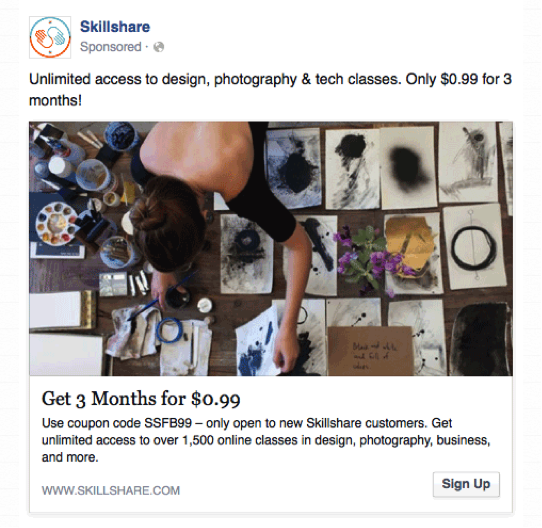
Once you get this right (and honestly, it might take a few attempts), you’ll have confidence and focus. All content you create will immediately appeal to the right person online.
First thing you’ll notice is that people will start liking your posts, commenting on your blog, emailing you asking: “Did you read my mind?!”
Because your writing, your product descriptions, your blog posts and adverts will feel like they are written for them.
And when people feel like you understand their feelings and problems, they’ll be start trusting you. And when they trust you, they will move a step closer to buying your product or service.
The practical results?
You’ll pay less for your adverts (because more people will click) you’ll attract more of the right type of customers to your website and this will over time turn into sales. (Assuming you have a great product).
Get crystal clear now, and when you get into advertising targeting options they won’t overwhelm you.
There’s a customer targeting worksheet in the free bundle. This is one that I use this with my private clients. It’s evolved from years of working with market research departments in large corporations and working with solopreneurs in online business:

#4 Inconsistent Social Media Bios
Picture this. You see an ad on Facebook in your newsfeed. It’s distracted you from scrolling and sparked your curiosity. The offer sounds perfect, but next you need to know if you can trust this business.
You click through to their Facebook page, scroll through the newsfeed, come to their website, click there and eventually end up on Twitter. You see an unused account with an old random looking personal image.
They’ve just nose dived in credibility
Consistency is crucial.
Check your bios on Facebook, Twitter, Pinterest, and YouTube etc. Each one should have a consistent use of keywords and hash tags. Make sure you have a coherent theme and message.
#5 No Cohesive Branding
As above, all visual elements of your brand must be cohesive.
Sounds basic, but you’ll be surprised at how many people don’t check.
Make sure colours and images on your social headers are the same. Use consistent imagery, and get all your social media profiles to have some visual connection to your website.
if you’re not sure what your website brand colours are use this tools to get exact colour codes from any image.
See how Ashley from Mad Lemmings has managed to keep his social media bios and branding consistent throughout his online presence, whilst at the same time being true to the individual platform. He shows clearly through his consistent use of red in his branding and the same keywords in his bios that his focus is on helping small businesses & solopreneurs with SEO and Wordpress:
On Twitter:
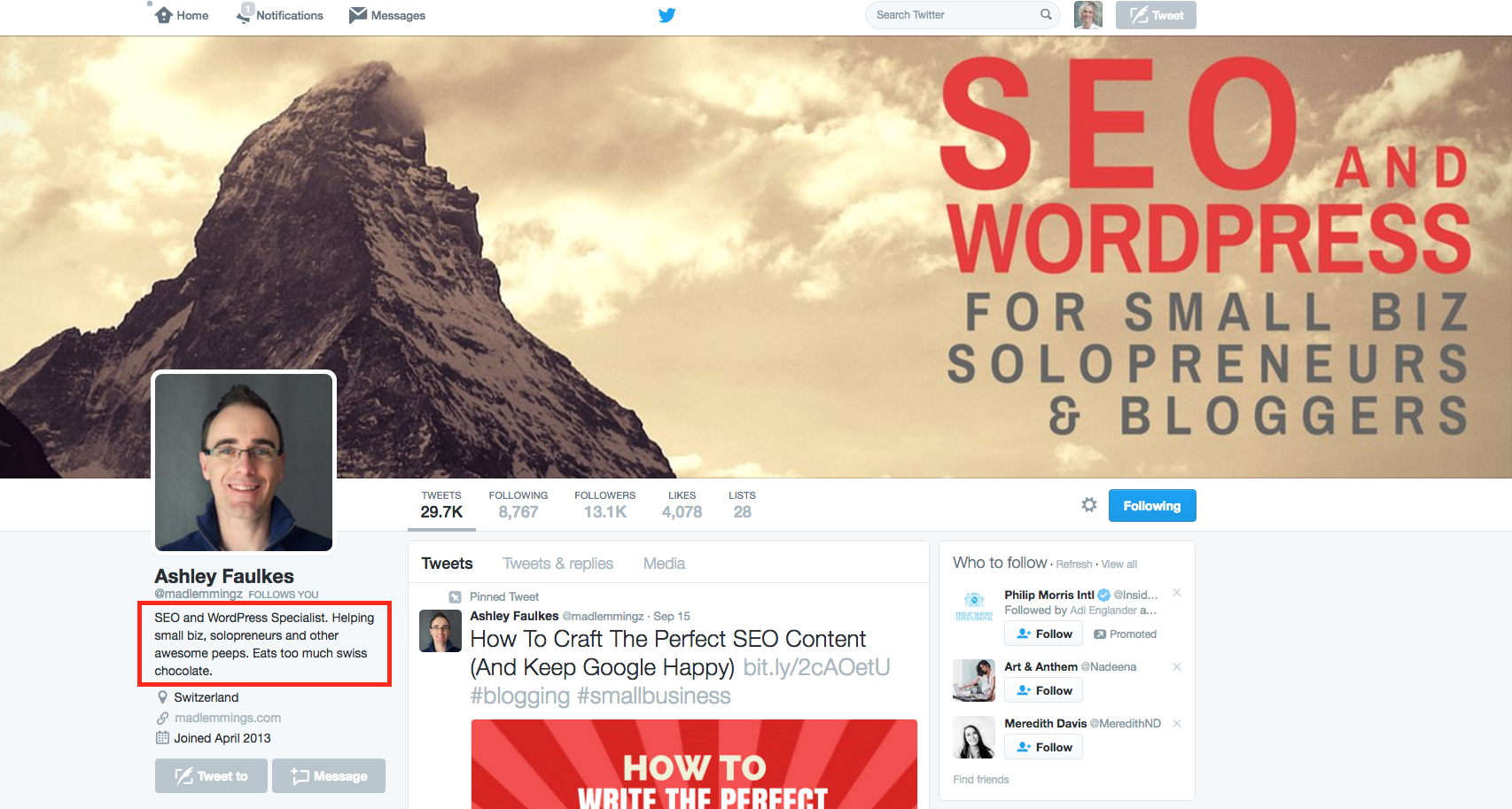
On Facebook:
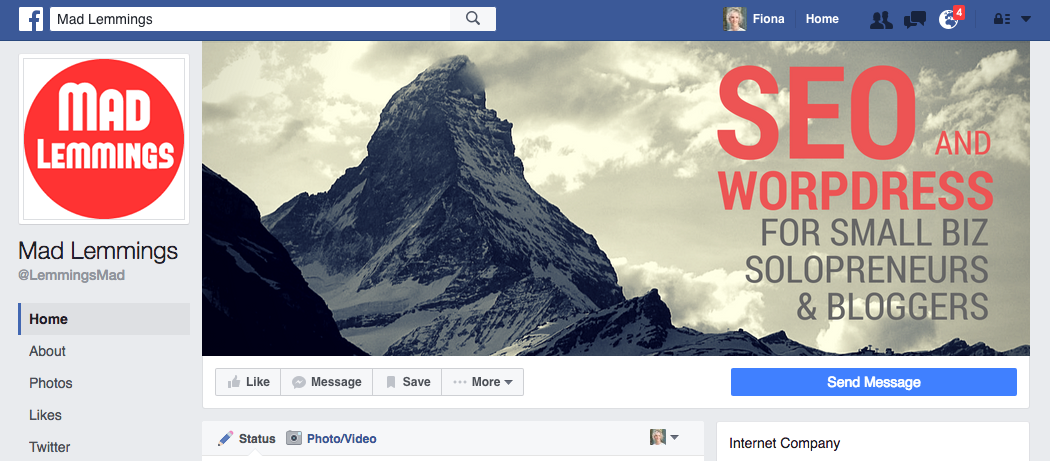
On Instagram:
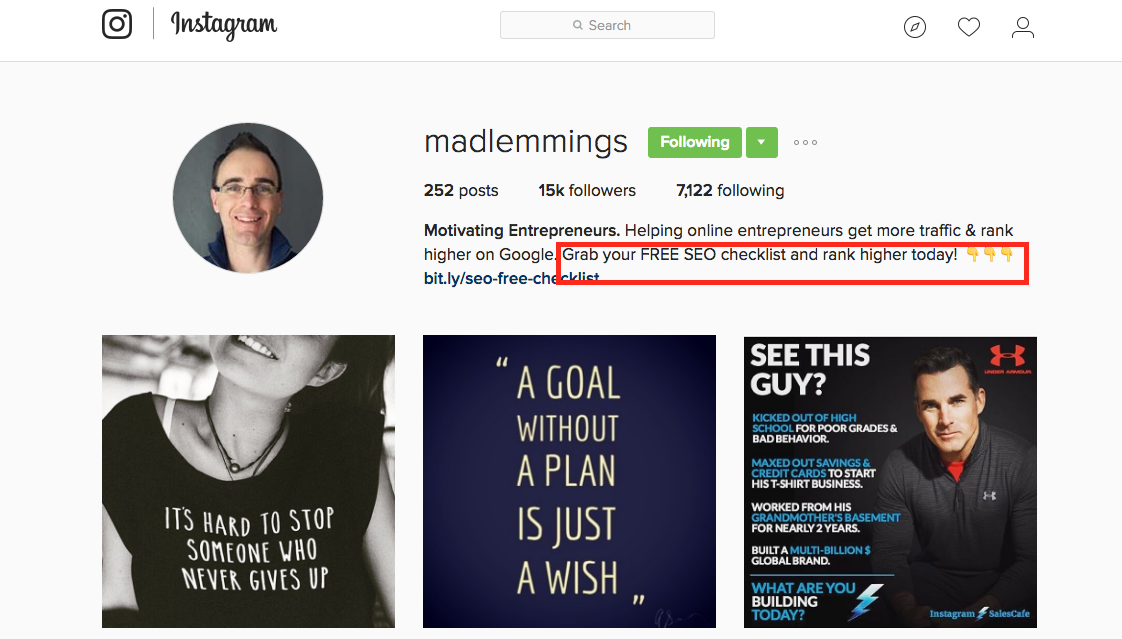
And on his blog:
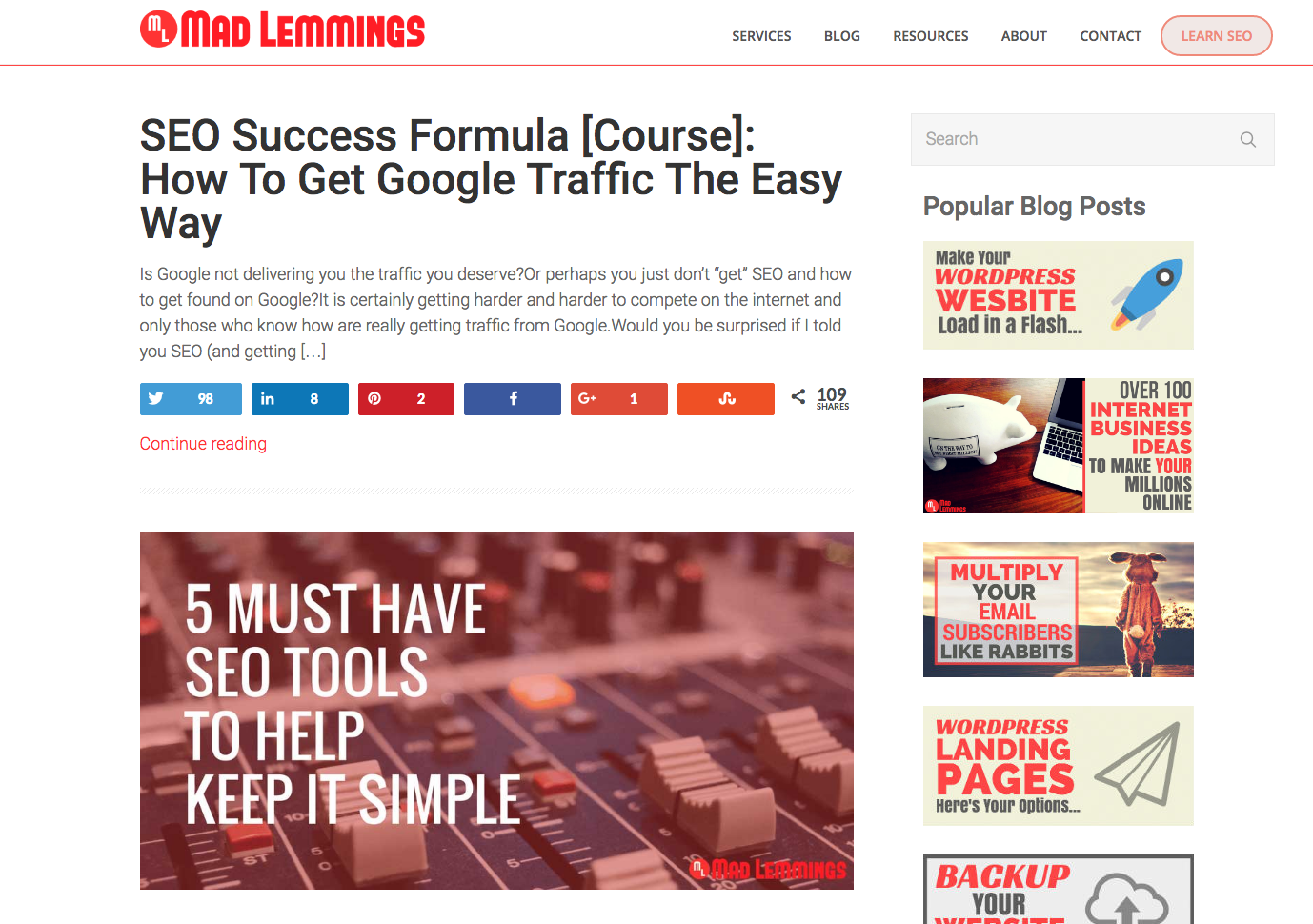
#6 No Clear Path To Action
This is vital if you want to get great results. Remember you defined exactly what you wanted to achieve with your adverts at the beginning? Now is the time to check the journey your new prospect will make after they click your ad.
Decide where you want to send people from your advert.
You may have heard Stephen Covey’s quote ‘Begin with the end in mind’ and nowhere is this more true than when you’re creating a paid ad – whether that be on Facebook, Google Adwords, Pinterest, Twitter, Ad networks or any other advertising platform.
Think ‘No Friction’.
Decide on your landing page and make sure that it is perfectly designed to take your audience from your advert to your website and complete the action you want them to, quickly and with willing intent.
What do you encourage them to do next? Make sure you funnel them towards the goal you defined earlier. I show you how to do this in detail in my 3-part sales funnel 101 series here, here and here.
And don’t forget to make it mobile. Most of the traffic you’ll get from ads on social will come via mobile. Does your website and your funnel work on mobile? Check it over.
If your ultimate goal is to drive sales then sign up for the free worksheet bundle here – I’ve included a sales funnel checklist to help you check every part of your funnel is working to get you great ad results.
#7 Paying Before You Test
Once you’ve got this far, it’s tempting to dive right in and get your adverts up and running. But there is one final pitfall to avoid.
This one is a classic ‘corporate’ marketing technique that will ensure you only pay to promote brilliant relevant ads….
…Use your own media first to test out your ad.
Post it on Facebook, tweet it, pin it or post on Instagram. Whichever is your chosen media make sure you share it to death with your existing followers first.
Then wait…
Wait to see how people respond. Does it get traction right away? How do your audience engage with it compared to other posts?
If you get a great response, then pay to promote it.
If not, tweek it and try again.
So there you have it – these are the 7-major pitfalls to avoid before you start advertising your business online. To get great results when you start advertising, make sure you:
Set goals
Clarify your offer
Define your target audience
Check your social bios
Create cohesive visual branding
Set up your funnel
Test organically
Be shrewd and get these right, or you could find yourself wasting time and money jumping straight into advertising and wondering why your results are less than stellar.
Download the free worksheet bundle which walks you through step-by-step exactly how to get ready to advertise so that you get great results. Click below ->

